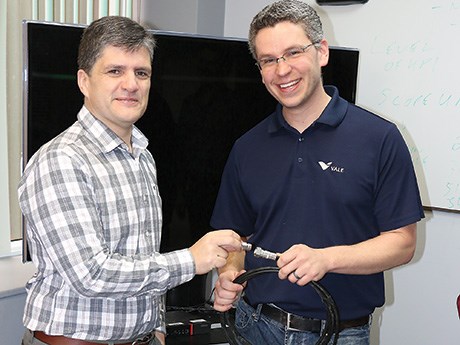Improved coverage, easier to install
Vale’s Canadian operations are pioneering the use of LTE networks in their underground mines. A wireless communications standard, LTE is commonly used for cellphone communications on surface, but until now deployments in underground mines have been rare to non-existent.
Brad Atkins, digital node leader for the technology team planning the rollout, says he knows of only a few trials globally: at Vale’s Sudbury operations, and an Agnico Eagle location in Quebec.
“The big difference for us is that it works on a different frequency, so it propagates better underground. It’s easier to maintain and less costly to deploy, which gives us more coverage in our mines.”
Vale currently has WiFi in its mines, but it’s not mine-wide because of the cost. For WiFi, mines generally have to call in an external company to splice the fiber, a delicate procedure requiring special tools. Also, “every device is an active device that has to be configured,” said Atkins. “It’s not something that a mine’s electricians can do. It needs co-ordination and the involvement of IT, whereas a lot of the devices used in LTE are passive, dumb devices, and the cable is co-ax,” which is much easier to work with.
With WiFi, there is more hardware that has to be installed. “In a 400-foot stretch to the back door of the crusher at Totten Mine, for example, we had to put in eight access points,” said Atkins.
“With LTE, we just put up one antenna and we’re done.” It can be deployed much faster and by a mine’s electricians. It also allows for communication at the face because of the signal’s increased reach.
Vale installed LTE in a straight run down the ramp at its 114 Orebody last year and just recently wrapped up a proof of concept at Garson Mine on the surface ramp down to the 600 level, a distance of two kilometres.
The team is now planning an LTE deployment at its Voisey’s Bay Mine in Labrador and will begin rolling it out at its other mines in Sudbury in May or June.
At Voisey’s Bay, LTE will replace leaky feeder, so miners will use phones instead of radios. At its existing mines in Sudbury, LTE will be deployed in parallel with existing WiFi and leaky feeder infrastructure.
While LTE offers many advantages over WiFi, there is one big drawback related to tracking. A critical application that allows mines to know the precise location of personnel, equipment and supplies, tracking is currently not possible with LTE.
“With WiFi, you can triangulate between access points, but LTE is just one long cable,” explained Atkins.
“We’re now in the process of figuring out how to track underground. We’re talking to chip set manufacturers and we’re reaching out to Google, Amazon and Uber for help.”
The plan is to splice in bluetooth beacons at 50-metre intervals, a strategy Atkins is confident will work.
Tracking is important in the event of an emergency because it allows control room personnel on surface to know where everyone is. “It’s also not unheard of to misplace a forklift or a scoop underground,” said Atkins. “It’s not as easy as finding your car in a parking lot.”
LTE offers more bandwidth, but there’s a tradeoff with penetration, requiring Vale to figure out how much bandwidth it needs.
More bandwidth will enable improved equipment telemetry and more autonomous operation of mining equipment from surface, where equipment operators are a lot safer.
“Using LTE at Garson, we placed a video call on a tablet to someone in Thompson, Manitoba, from the 600 level in a moving jeep going down a corkscrew ramp using one antenna in a cutout on the 100 level.
By comparison, said Atkins, “we have 40 or 50 WiFi antennas on the ramp at Creighton to track and communicate, and ramp time is almost impossible to get if an access point goes down. We don’t want to put our people on the ramp to maintain equipment because it’s a busy place.”
With WiFi, you can’t put an antenna in a cutout.
Because of the cost and logistical problems associated with WiFi installation, “we always had to justify connectivity,” said Atkins. “We wanted to get to a spot where connectivity is like air, power and water. We’re now at that point where it’s in capital development plans to advance wireless connectivity. It’s a monumental shift. We’re past the justification process. We know we need it.”
Vale is budgeting between $1.5 million and $2 million per mine for LTE deployment, most of which is the cost of the radiating cable.
“It’s exciting and scary at the same time,” said Atkins, “but we’re pretty confident we know where we’re going.”



